Roni
Member
Hi,
The previous trip report part:
India 2012 - 2: Gwalior - Bilevel Suburban Trains (50 p.)
http://railroadforums.com/forum/showthread.php?t=39525
The accompanying video:
http://www.youtube.com/watch?v=Ln9ntoVBVts&hd=1
February 5 2012
We are on a morning chase along along the longest 610 mm narrow gauge railway in the world, Gwalior - Sheopur Kalan, on the way back to Gwalior. Now we had to fight our way back to National Highway 3 which went without problems, Bamour Gaon was reached well before the train arrived. By the way, if you want to cross a road with lanes separated by barriers here you dont drive in the correct direction until you find a gap, you follow your desired direction on the right edge of the (lefthand traffic) lane!
Little boy, tall bicycle.

Back to NH3.
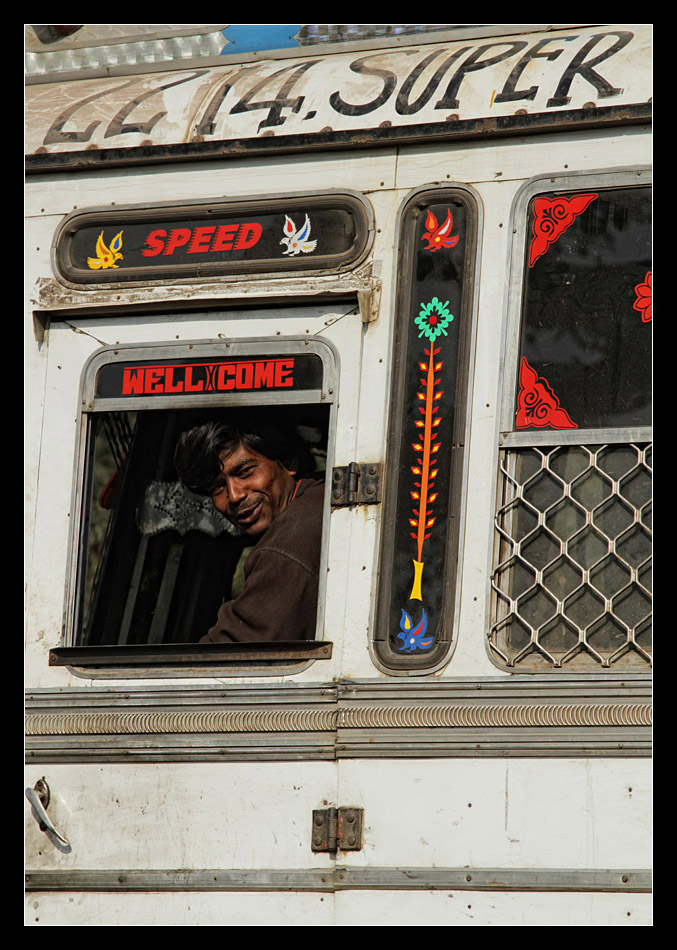
Arrival of NDM-5 802 hauling 52174 Sabalgarh - Gwalior passenger into Bamour Gaon station.
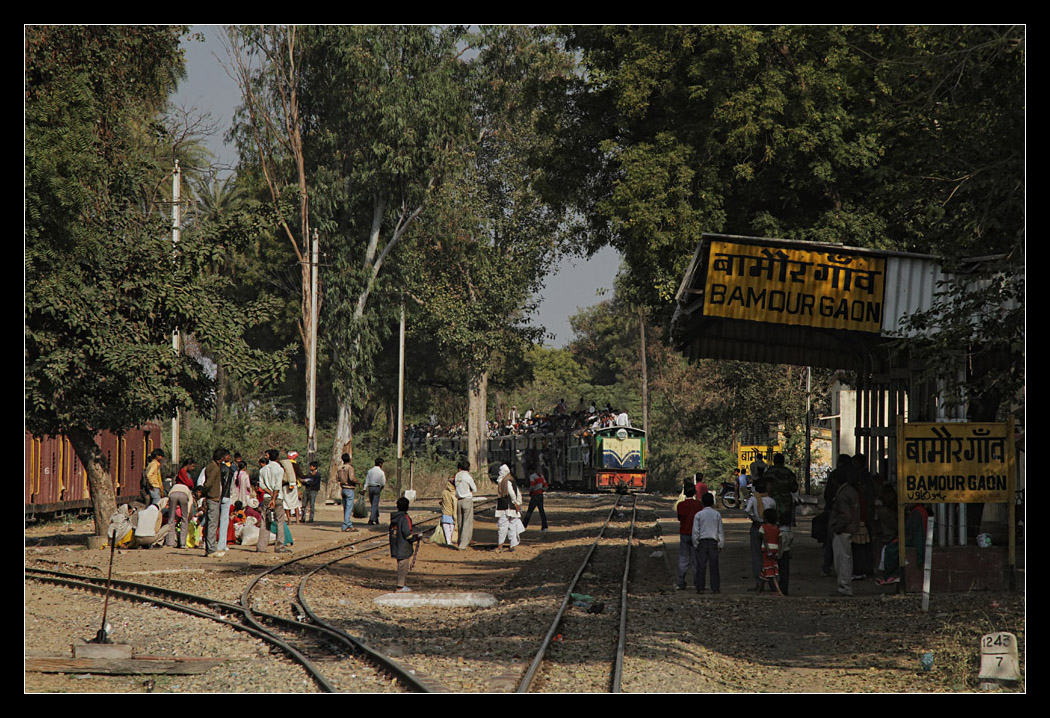
At Bamour Gaon I met once more a few cool guys posing in front of my camera, some even played model while my video was running and others checked the results on the screen. The train came by soon and everybody from driver to guard discovered the photographer, from now on the whole train cheered me on at each spot.
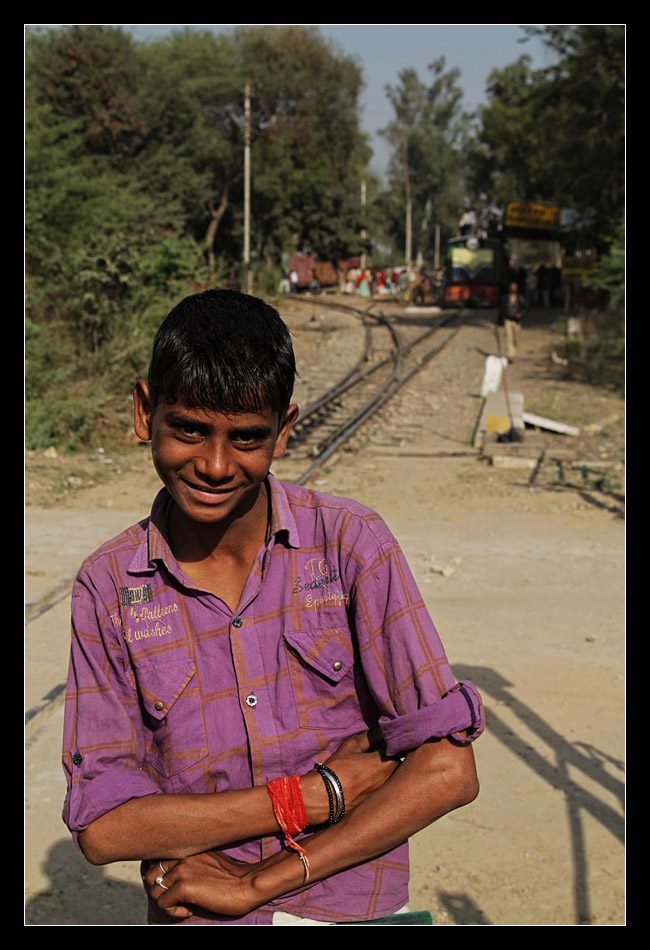
NDM-5, already equipped with LED lights. Guards at level crossings, on locos, in the rear coach of trains and at stations all show green or red flag signals in India, flashing lights at night.
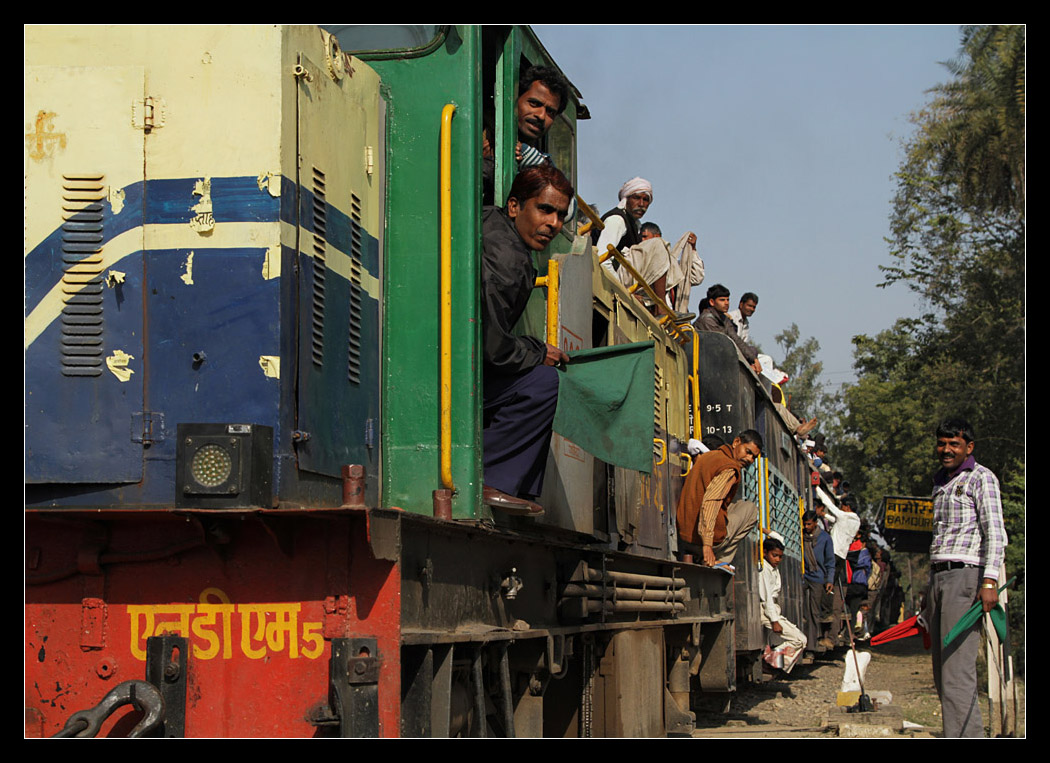
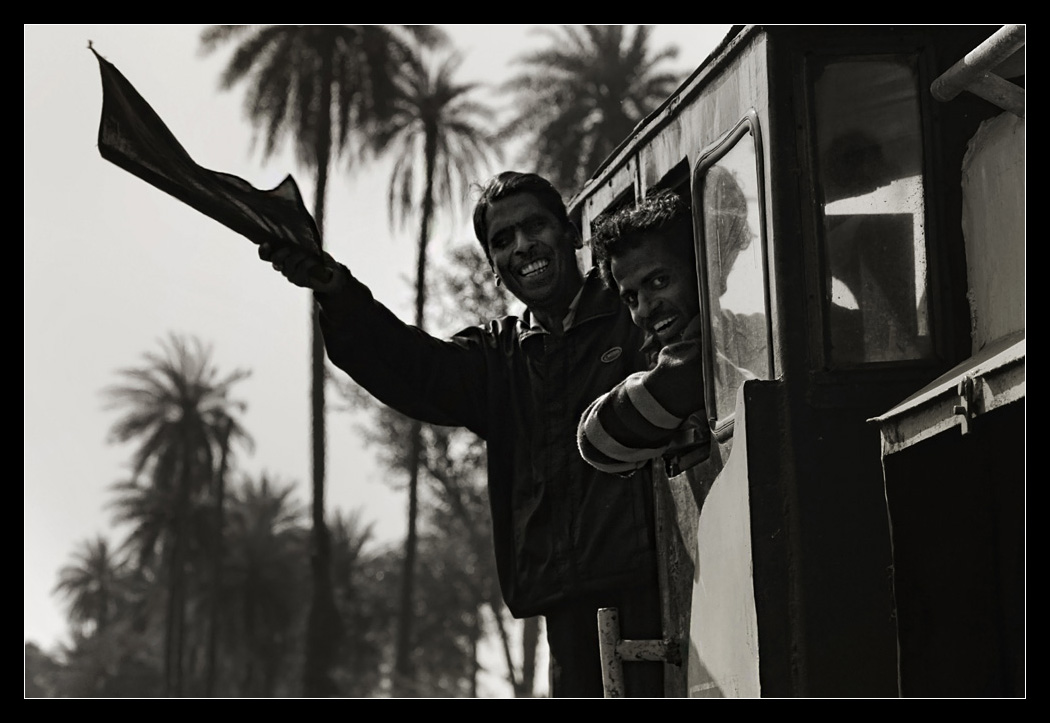

Moving south along NH3.

Ride directly behind the loco exhaust.
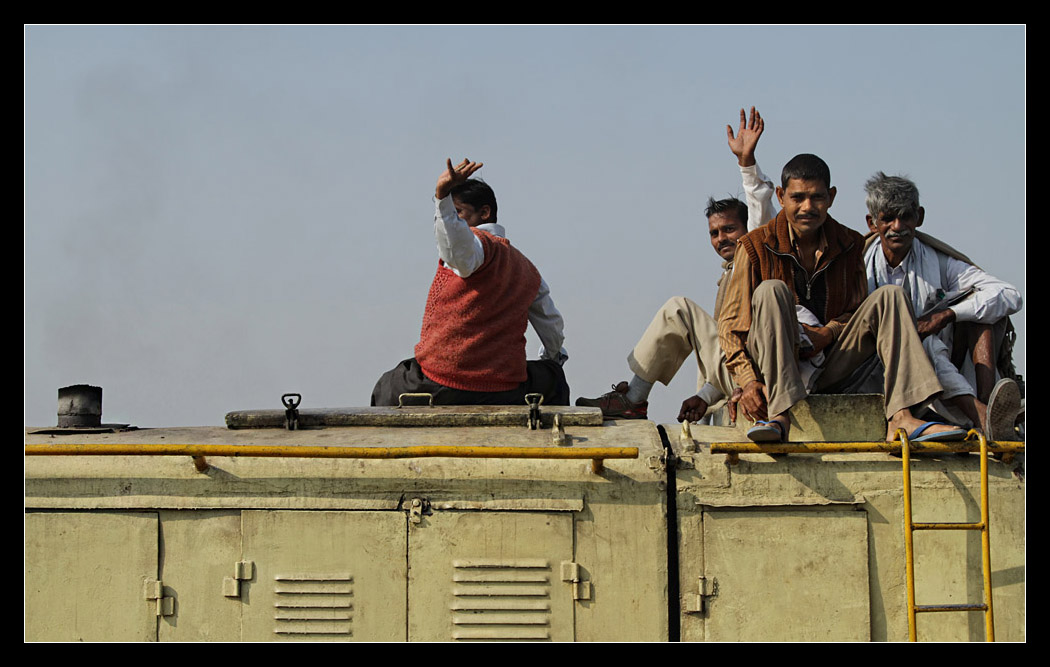
Air-conditioned rooms are offered here - *cough*!

Now I got to know the bitter reality of NH3 during daytime. It is simply a chaos of dust, traffic and the people having to live or work beside it. Of course sensational to take pictures of, but only if you know you will get away from it soon.
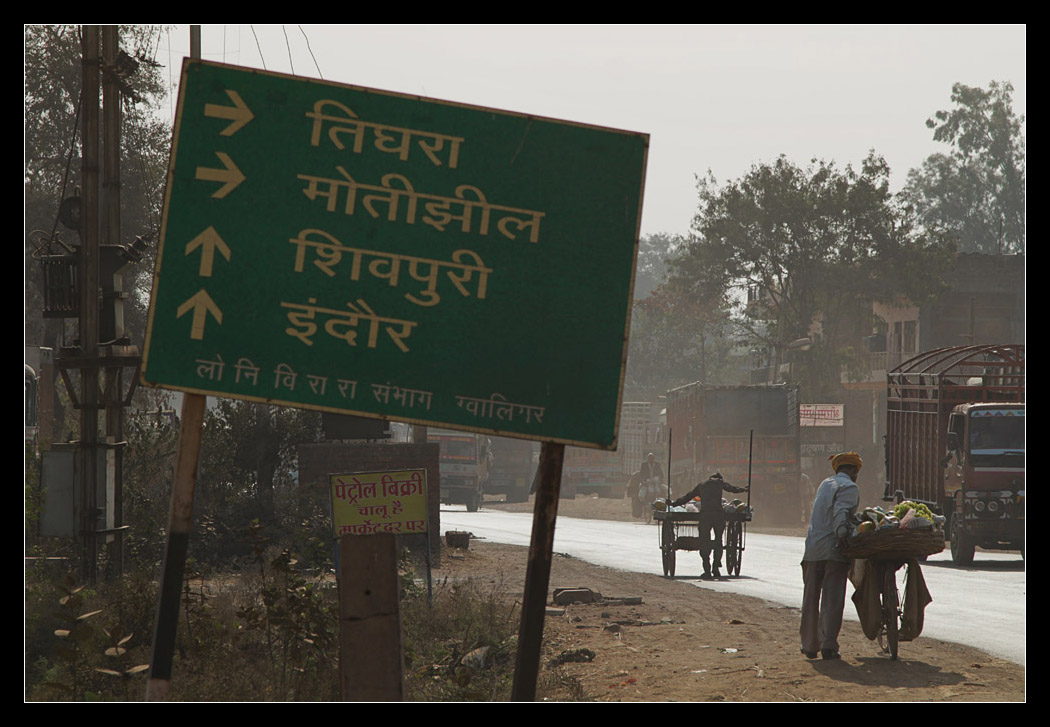
Cows - everywhere...

Somewhere inbetween: the train.

At both level barriers across NH3 we stopped in pole position, actually at the second one we had passed the first gate but did not make it through to the other side. The barriers are always manual gates, automatic ones would not work here. But it did not matter, we just stopped in front of the second gate inside the level crossing, there is enough space for road and rail vehicles. Only as both gates were not opened simultaneously afterwards the problem arose that the traffic pushed across from one direction preventing the gate on the other side to be opened at first.
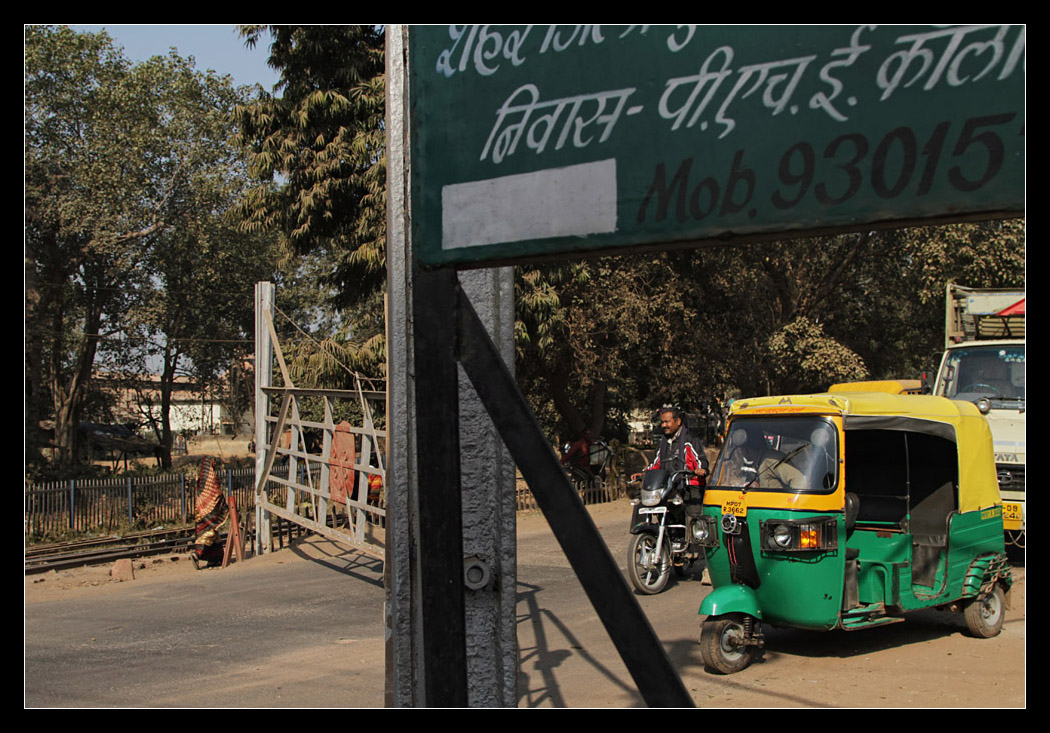
Meeting the second train of three that day from Gwalior, 52175 GWO SBL passenger, at Motijheel station. Both trains were now delayed 35 minutes. This train frequency on a suburban line serving a population exceeding a million people explains the rooftop riders. As most people are not paying, the line is highly deficient, so improvements of service in the future are unlikely.
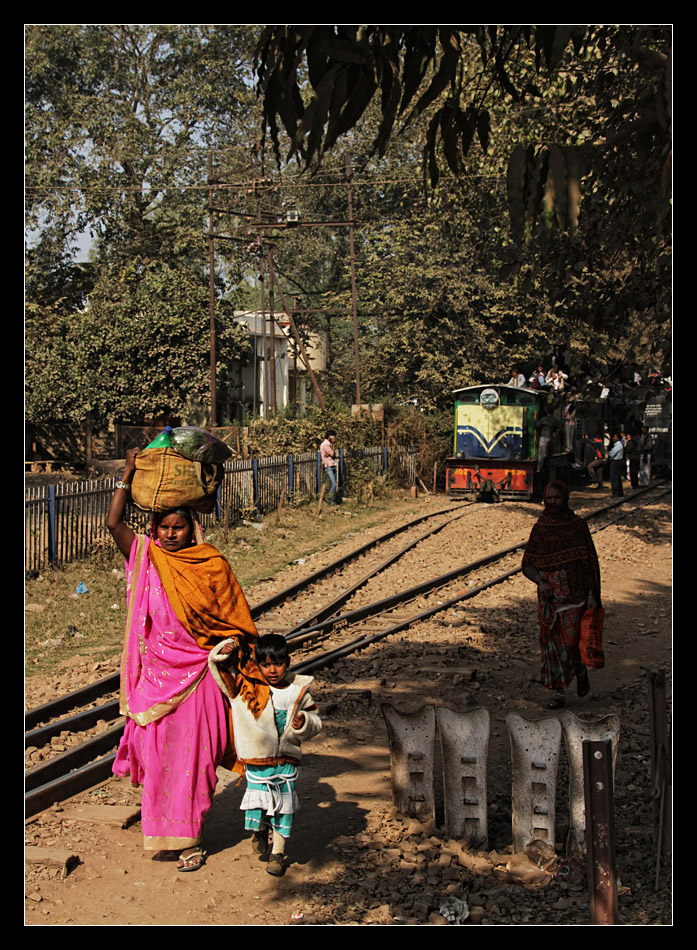
Thanks to poleposition we soon had passed the long line of waiting trucks and were in hot pursuit of the train.

These minivan-tricycles are the only means of public transport here - the number shows the route - , equally completely packed.

Waiting in the shade at the next level crossing.
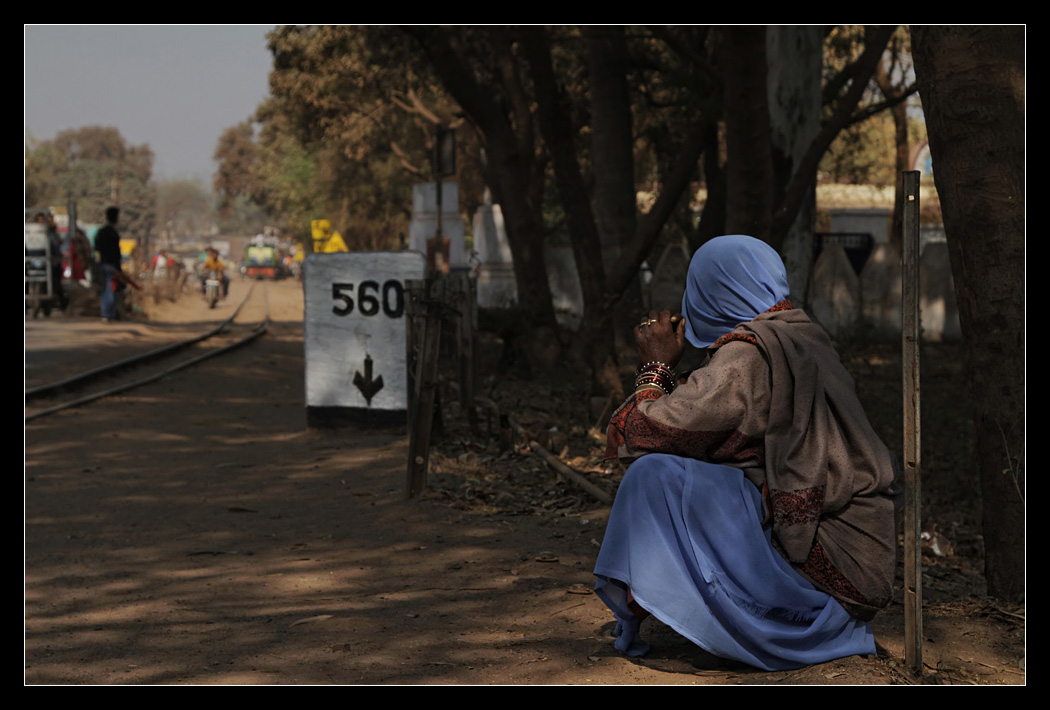
A few bikers squeezing past the gate.

As last spot I chose the Gwalior side of the level crossing gorge from this morning.
Through the gorge.
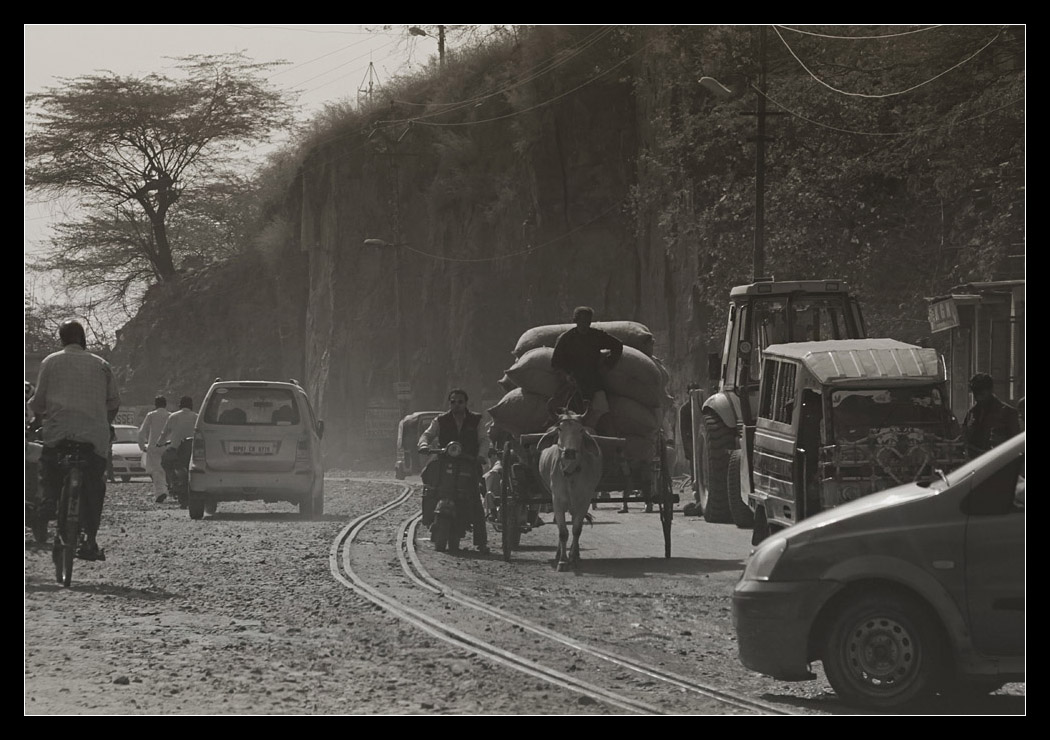
Campaign posters everywhere.
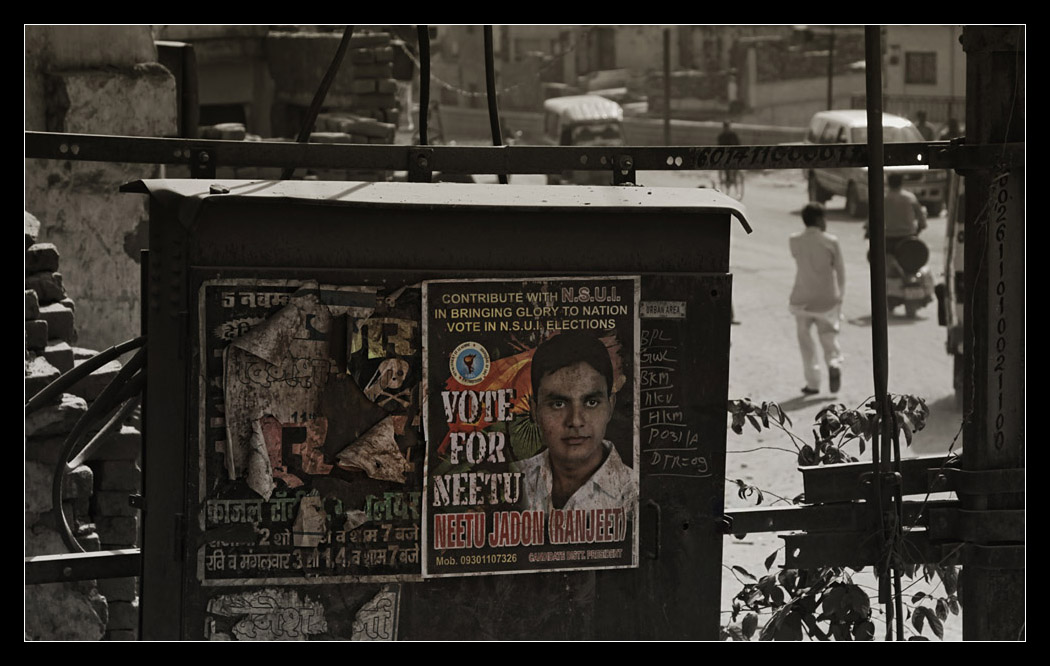
The train passed a temple and the gates, again it did not matter on which side vehicles were waiting.
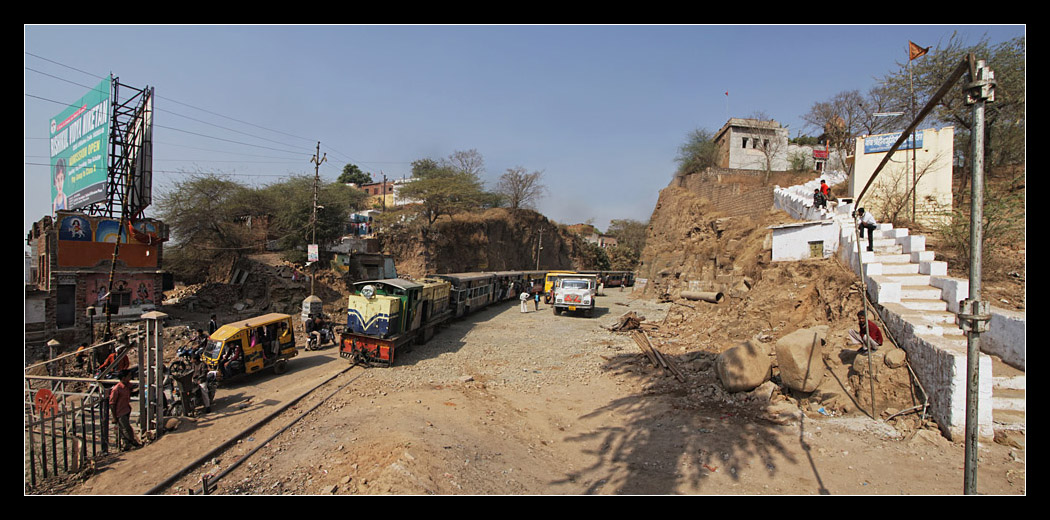
The mighty fort, a term used to describe a fortified hill. Fortifications usually are built around the edge, inside several palaces, temples, other city buildings and gardens can be found.

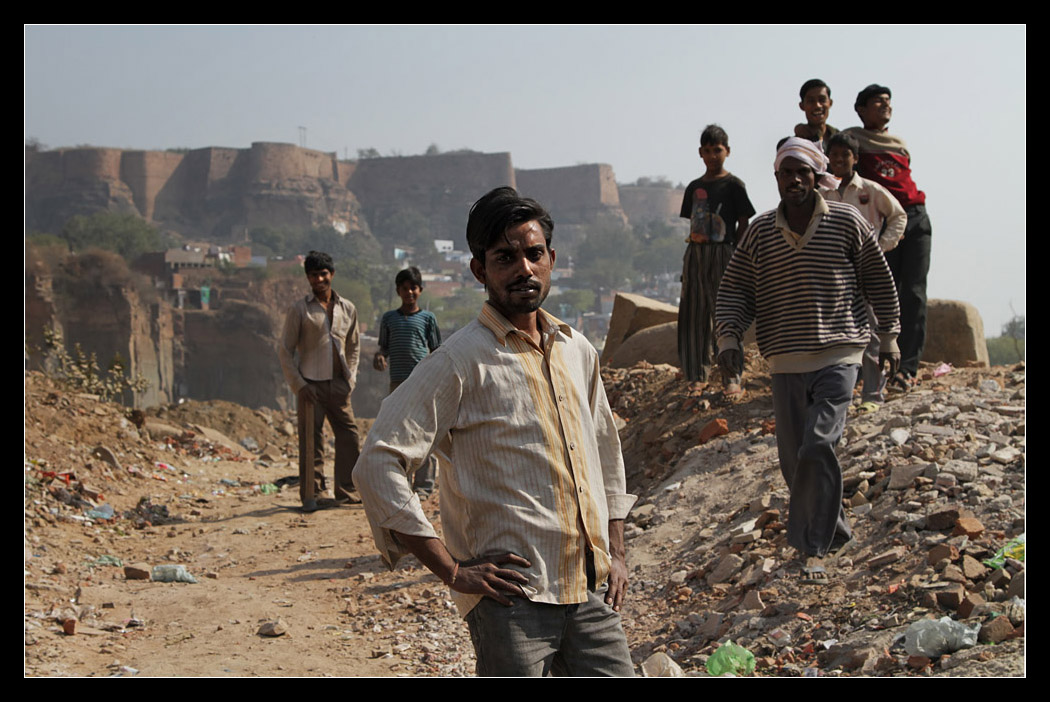
After I had taken the last shot successfully, a view back at the fort with some youngsters from a nearby quarry, Salim took me uphill through Urwahi Gate on the side away from the city into the fort and set me down. Now it was time for some quiet, and a shady cutting cooled by water trickling through the rock walls of Urwahi-Valley next to interesting 15th century Jain sculptures provided a pleasant contrast to dusty streets. The figures ranged in size from massive to very tiny, according to a booklet bought on site they are impressive in size, but more skilfully carved ones can be found elsewhere.
More detailed information about the history of the fort:
http://en.wikipedia.org/wiki/Gwalior_Fort

Ascending again to the plateau I made the acquaintance of another alone-sightseer, a financial employee of a local energy corporation. In the beginning you are of course a little more distant as European, but the Indian hospitality without compromise wins you over in a heartbeat. He had no clue what exactly could be seen here, but we wandered straight towards the main attraction, Man Mandir Palace. While replenishing water and buying the tickets I could not look that fast, my companion had already paid for everything, only at a later occasion I managed to pay thanks to lightning reflexes. You have to remember that entrance fees for sights are cheap for Indians, but tourists often pay a mulitple amount. My Indian acquaintance called that fact a scam and said tourists should pay the same as Indians. At least I got a golden 100-rupee-ticket.

Man Mandir Palace facade, built from the early 15th century and refurbished in the late 16th. Other parts are dauntingly ornamented with small yellow ducks.
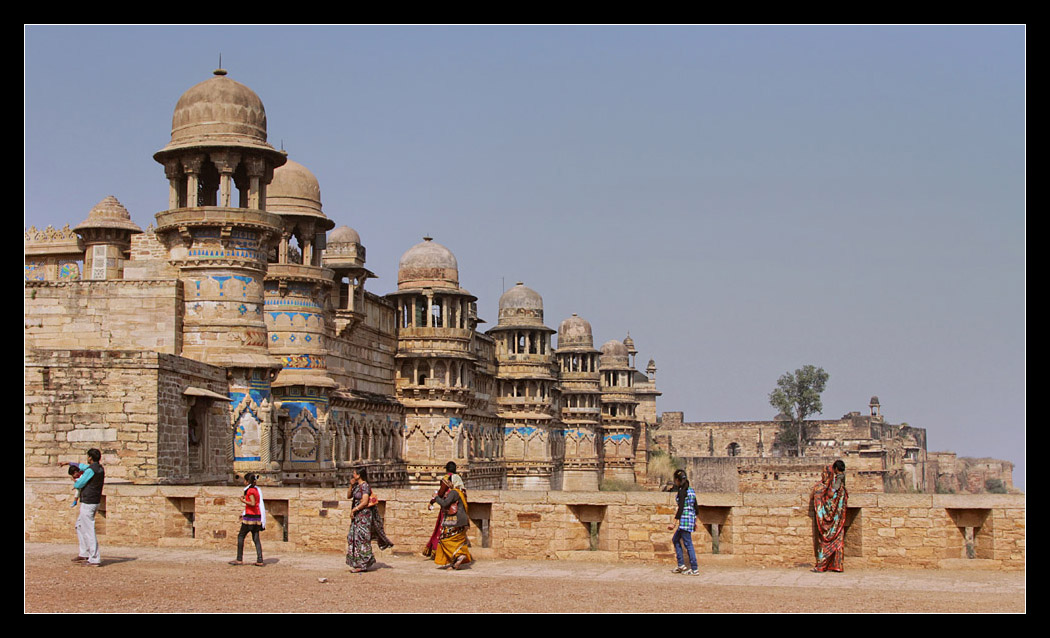
The palace was impressive on the outside, also the location high above the city, but inside there is not much to see apart from a view into the psyche of former rulers. You only find very narrow passages leading into few inner courtyards and underground halls. Through the doors of the harem fitted only people with a height of less than 1.50 metres. My buddy noticed that in modern times rat traps had been used as lightbulb covers. Apart from that I met the first European since the Mumbai hotel.
The road from the city centre to the main gate Hathi Pul ("Elephant Gate") - the only entrance elephants could pass.
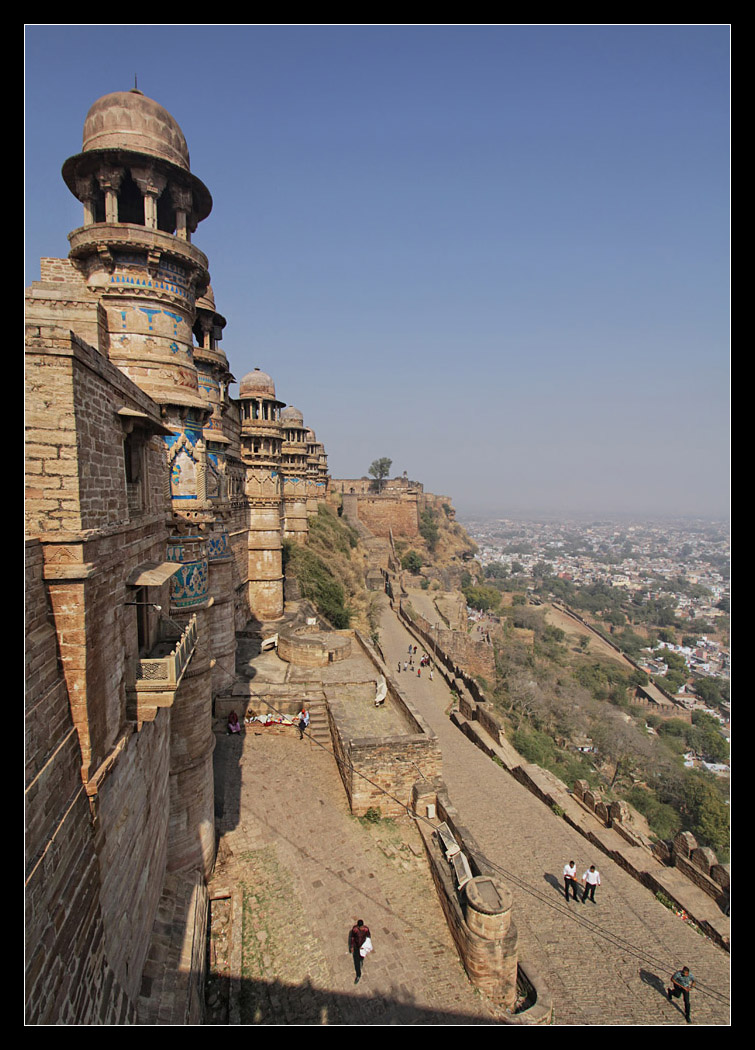
Inside the harem - men rarely got in, women almost never out...
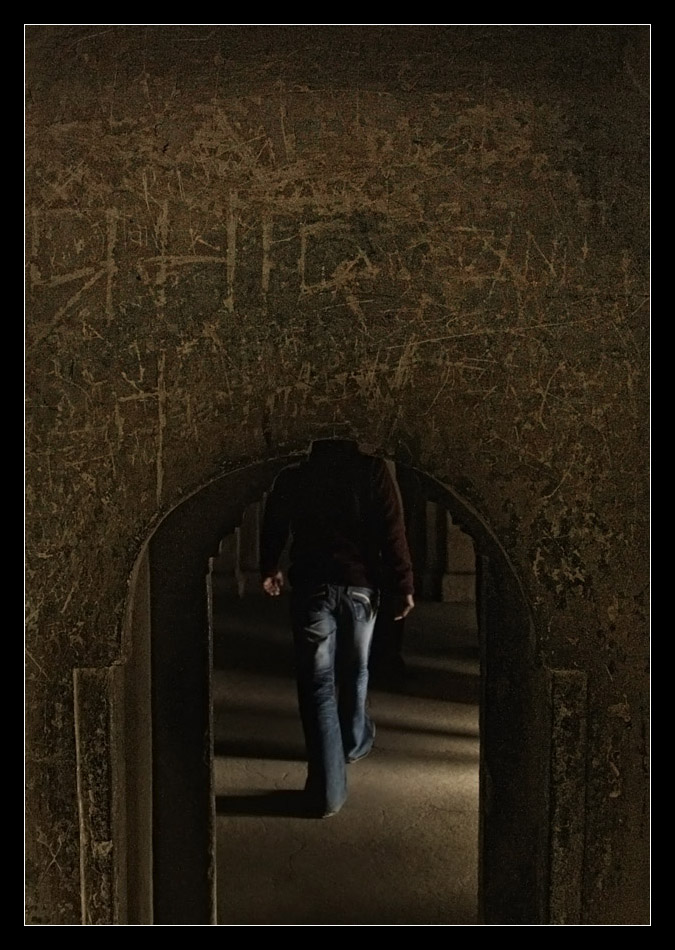
Magnificent decorations of a courtyard.
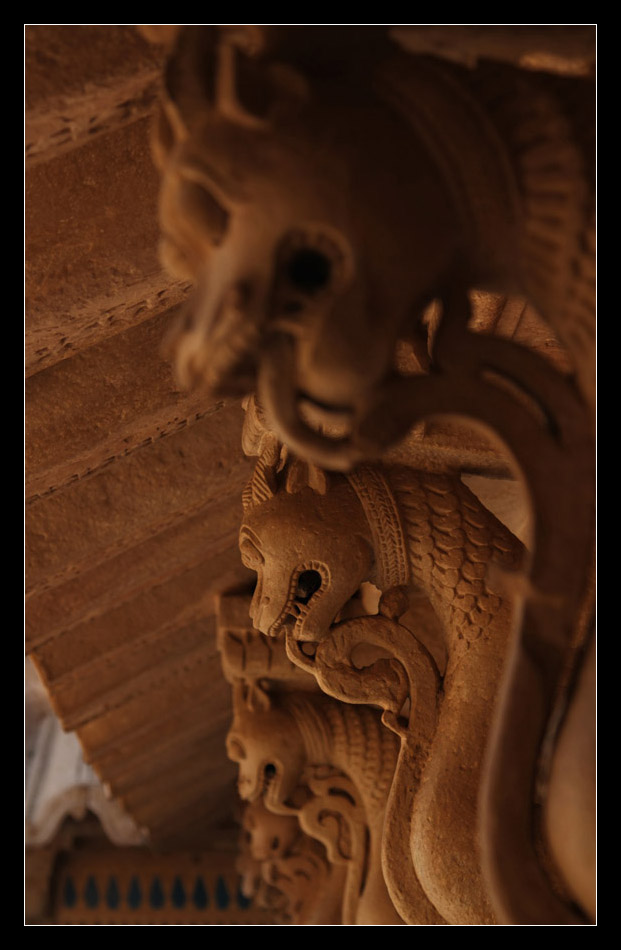

After this adventure we moved on to the second main sight of Gwalior, the palace of the maharaja family Scindia. Nobility titles were abolished in India more than 40 years ago, monarchy even earlier after independence, but the families still are quite powerful.
We walked down the steep road and boarded my first time a tuk-tuk. These three wheelers dominate public traffic in most Indian cities, cars as taxis can mainly only be found in metropolitan areas. The autorickshaws are of type Piaggio Apé, obviously an Italian company has earned well here. My companion negotiated a price of 40 rupees, and on we went, into the traffic chaos. On the way we ran into an obstacle, a muslim festival, and had to take a detour. Already we heard from the driver that the fare had expired, but he bit on granite and only got 40.
One of the city gates at the foot of the hill.

My first tuk-tuk ride, also viewable in the video.
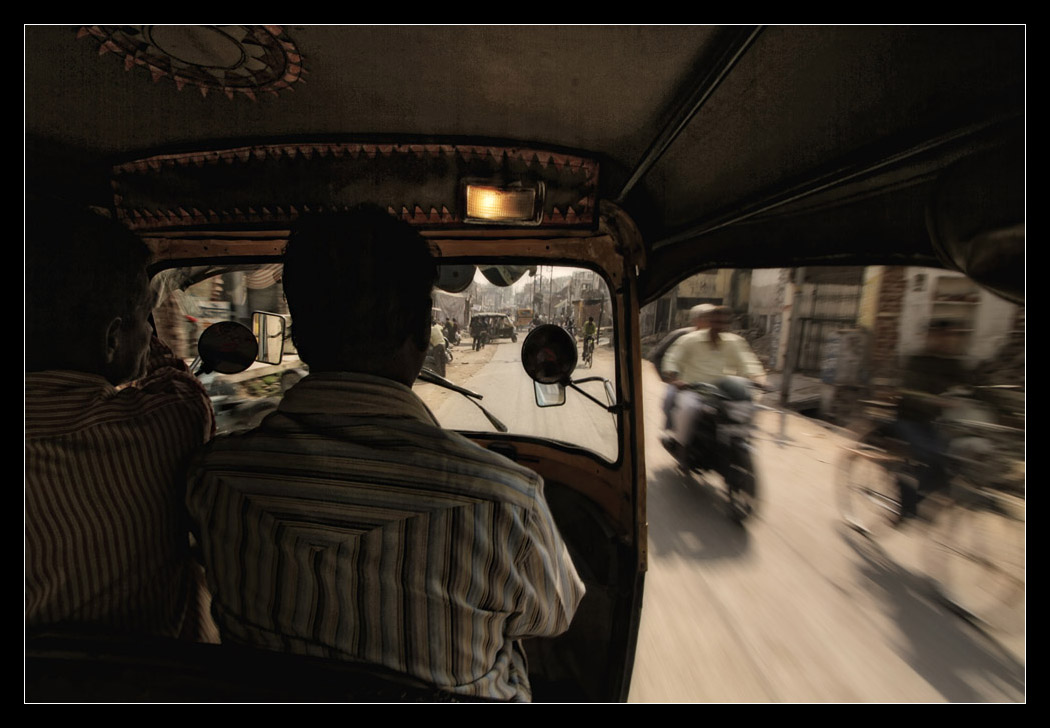
Jai Vilas palace is a sight of the tackier kind, constructed early 19th century in various Italian styles, a museum showing the forming living quarters of the maharajas. The other half of the complex consists of the current living quarters of the maharajas. But a few curiosities were on display, also some particularly interesting to me, as former maharaja Madhavrao Scindia had been railway minister from 1986 to 1989, for example in charge of major computerization progress with Indian Railways. Already in the park outside a private rail vehicle was exhibited, even more inside but sadly covered by cages and difficult to take pictures of. This time I was quicker paying the 300 rupees for me - quite expensive at about 5 Euros - , 60 rupees for my camera and 40 rupees for an Indian citizen. At the ticket check my friend was asked to leave his mobile at the entrance otherwise he would have to pay 60 rupees for the inbuilt camera. He shortly marched out and back in again, of course he only had put his phone into his jacket. The first part of the museum was quite interesting, at the women's pool - completely sealed off - mostly 10th century stone sculptures which had been found around the fort were exhibited, some even dated back to the 2nd century BCE. Then we walked quickly through the former living rooms where some excessively luxurious items were on display. My companion was enraged about the waste of tax money with all the poverty outside. Sensibility about poor people is quite high also with richer Indians, I did not see anyone act carelessly.
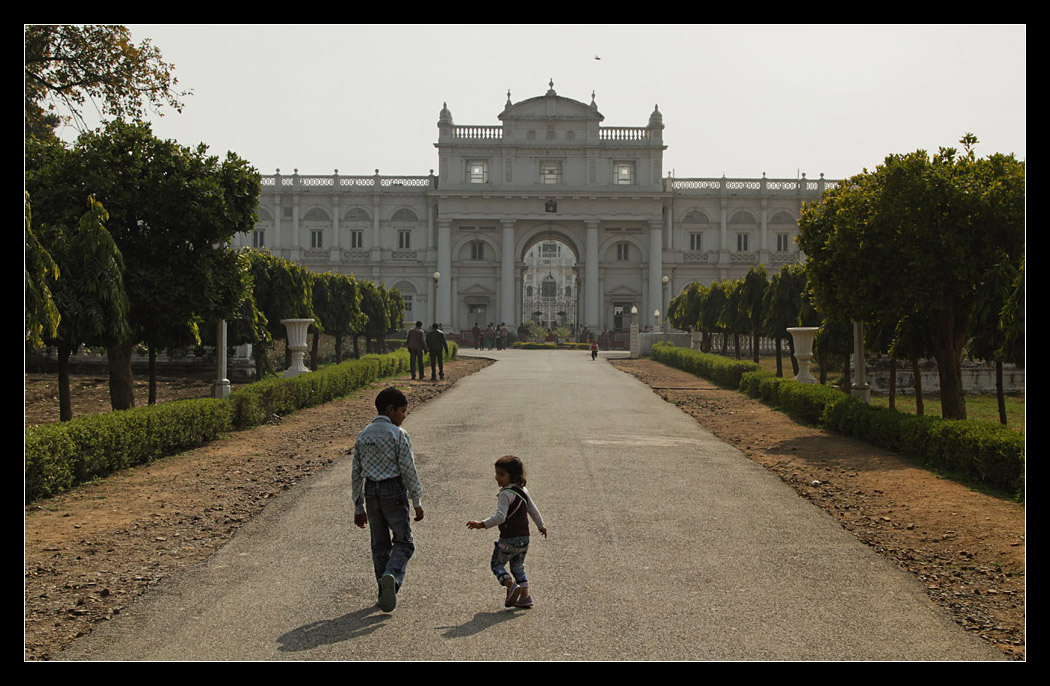
In a showcase models presented to the railway minister were exhibited - from WAP-4 to WP class steamer - right at the bottom suddenly I discovered a pair of H0 subway "Silberpfeil" ("silver arrow") EMUs from my hometown Vienna!
As there is no more space in this report I posted a few further railway impressions from the palace here:
http://forum.irfca.org/showthread.p...-the-Maharaja-s-(Model-amp-Real)-Trains-(10-p.)
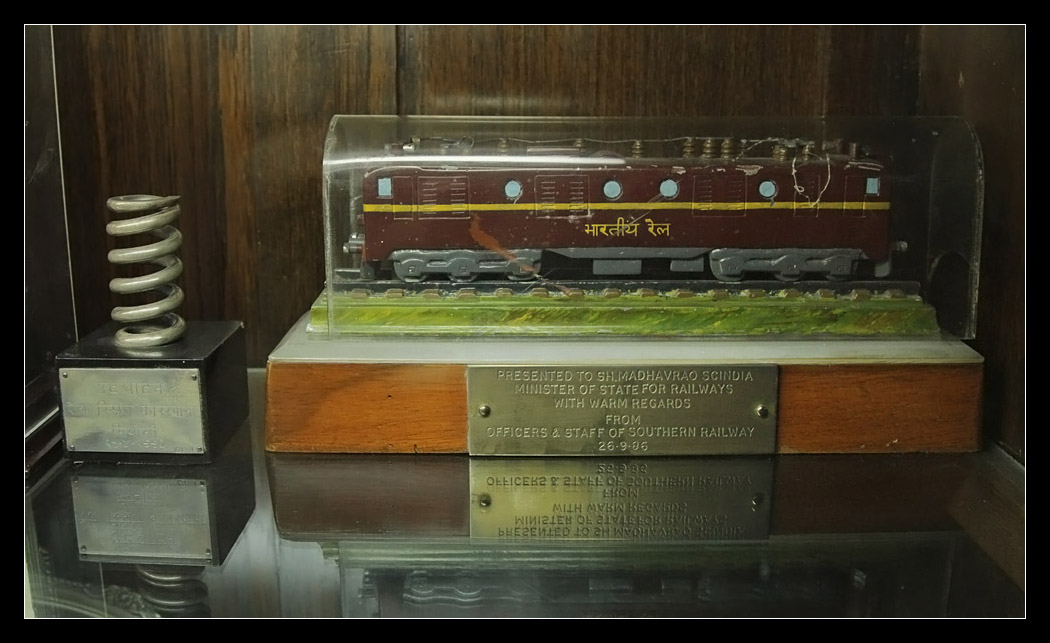
However, the most important railway highlight is well known outside India, too. In the great dinner hall a model railway track was set up on the table, the corresponding train inside a showcase in front of it. It consists of a silver steam loco pulling 7 coaches with bottles and bowls spelling the letters of the family S-C-I-N-D-I-A. As soon as a guest takes a vessel the train stops and starts again once the vessel is returned.


The tracks with electric rail in the centre.

Right next to it you could find a dinner hall with pillows for seats on the floor where you would expect any moment - indoctrinated by pop culture - to get served a fresh monkey brain. I also could take a photo of a stuffed tiger, at least nobody can tell me I did not see any in India - first animal on the list: check! Next we looked one story up into the most impressive room of the palace supporting seven tons of chandeliers hanging from the ceiling.
Two of the world's largest chandeliers.

Back into outside reality, where cows were eating burning garbage.
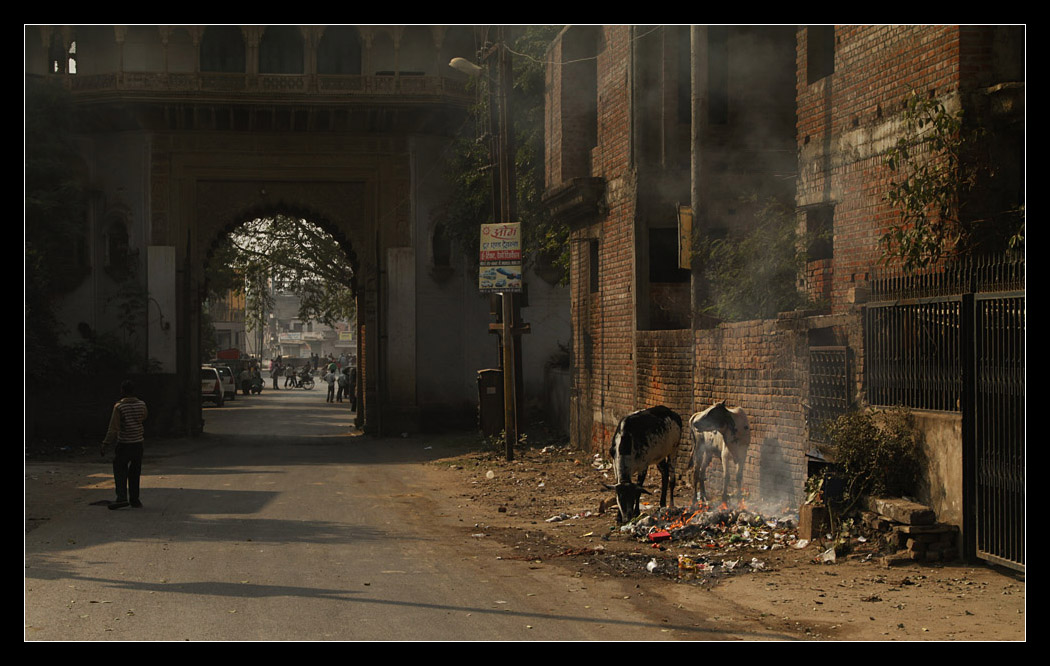

Now my friend wanted to invite me for lunch, into the outdoor version of a fastfood court. On the way we had to pass the Muslim festival with people wearing green flags and a few youngsters doing motorcycle tricks right inbetween the crowd. During eating I still was a little careful, we had Chinese, but nothing extraordinary happened to my stomach afterwards.


Walking back to the hotel after lunch I only had to wait shortly on the railway bridge in the afternoon traffic and already Erode shed WAP-4 22360 came by with the half an hour late 16787 Tirunelveli - Jammu Tawi Express, so practically a route from the southern tip of India to the far north. The longest distance train in India only covers two hundred kilometres more, this one manages from Tirunelveli, departure 15:45, to Jammu Tawi, arrival on day 4 at 13:10, 3561 kilometres in 69:25 hours. Gwalior is reached at kilometre 2655 of the trip.

Entering stations Indian trains slow down to crawling speeds not to endanger human lives. People jump off and hop on outside the platforms, too.

View towards the station, sadly blocked by too many catenary masts.

A street corner on the way to the hotel.
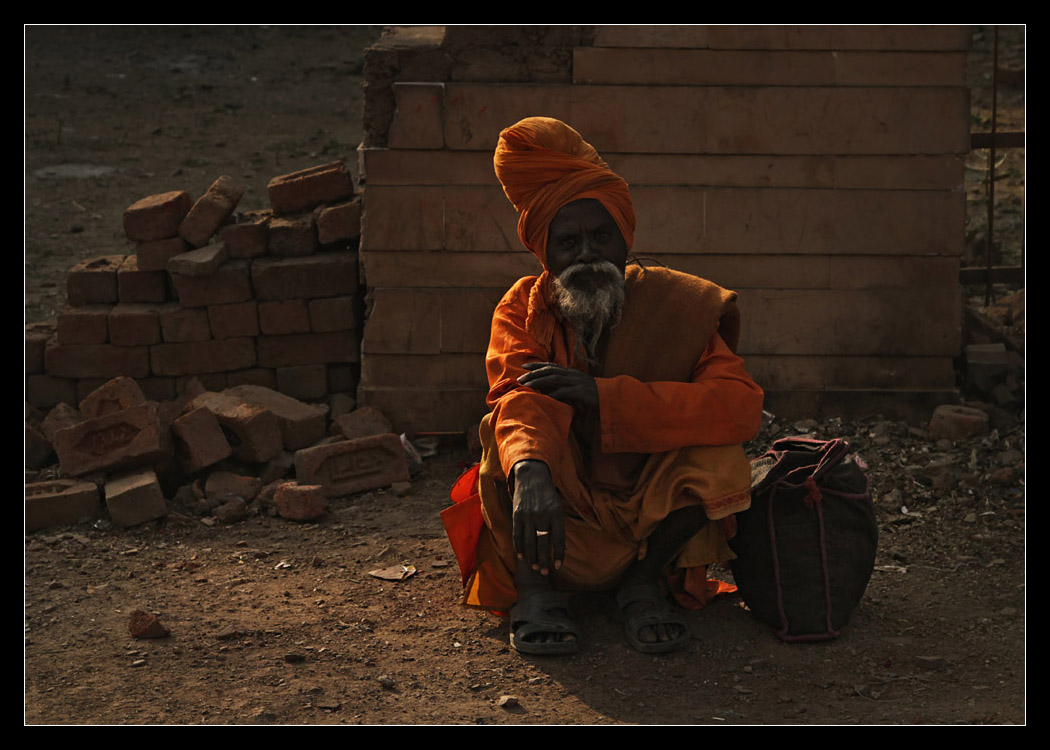
Now I had to rest in the hotel lobby, my companion went on to the rail station where he would pick up a colleague from the Shatabdi I would depart with, by chance even from the same coach. After six the hotel staff gave me a free transfer to the station, my train only would depart after seven. I immediately found my friend on a bench at platform 4 and we spent the rest of the time chatting.
No platform is without life here, but mostly clean and equipped with good facilities. The LED displays will show the coach numbers upon arrival of a train, at the moment only the station code "GWL".
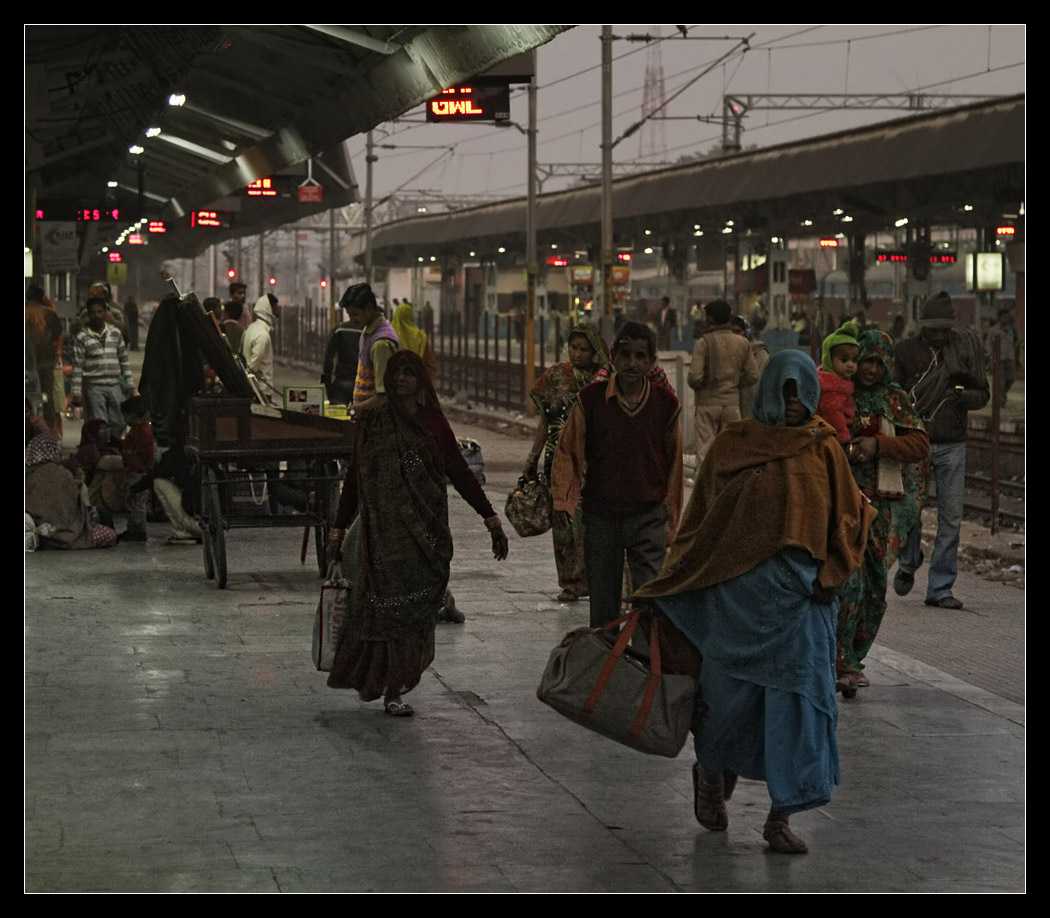
On the other side of the platform the narrow gauge line was starting, the 15:40-train still was waiting and would only depart with almost three hours delay at 18:30. IRFCA-friends told me later that a loco had collided with a tractor on the line that day.
The narrow gauge train 52173 Gwalior - Sabalgarh on platform 5, next to NDM-5 801 gravel and sand supplies.

Local amenities are provided everywhere, so you can start your journey practically without any provisions. In the background NDM-5 808 produced a lot of smoke even in idle gear.
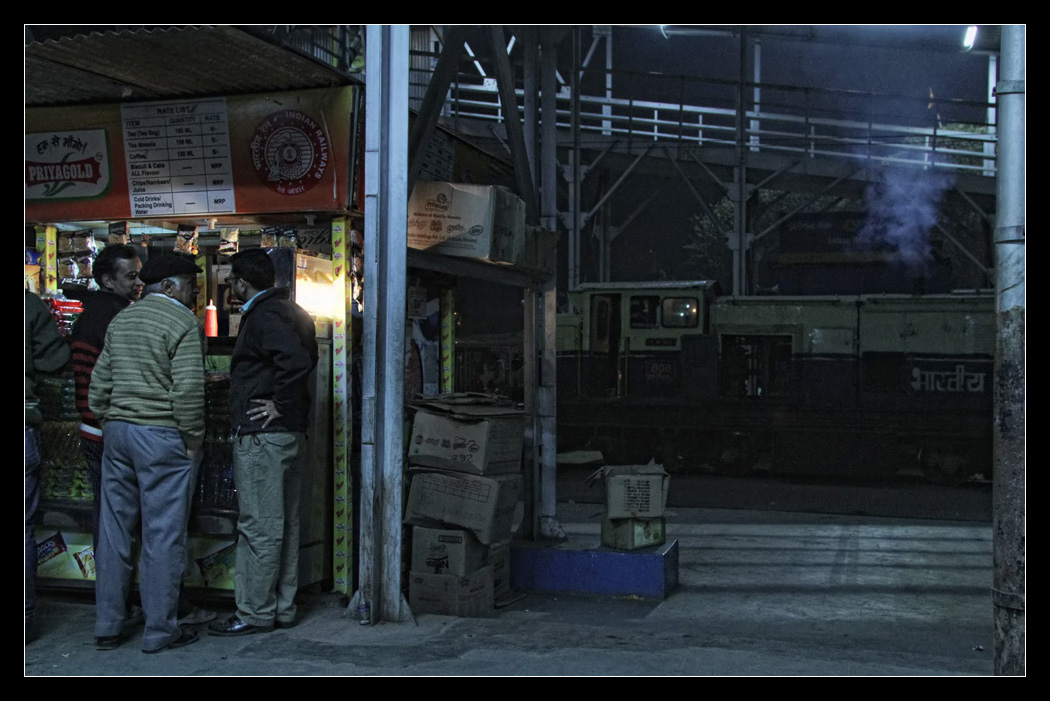
Now it was time for my ride with the fastest train of India, the 12002/12001 New Delhi - Bhopal - New Delhi Shatabdi, travelling at an average speed of 93,05 kph and reaching speeds of up to 160 kph on the Mathura - New Delhi section. Shatabdi means "centenary", this fast daytime express class was introduced by our good old friend, the maharaja Scindia, in 1988. The name refers to the 100th anniversary of the first Indian prime minister's birthday.
I only rode two stations from Gwalior to Agra Cantonment:
A WAP-5 class - a different-looking relative of SBB Re 460s, my loco was Indian-produced, the first batch of the series in Switzerland - brought the LHB-rake of German design punctually to a halt. I said goodbye and took my seat in the middle of three in a 3-2 layout. The seats had textile covers, everything felt largely European. Only the service was better, within a short time from Gwalior to Agra the train only took 1:20 h water, grissini and dinner were served. All inclusive in the AC chair car ticket, the lower class of this train, partly filled with Asian and European tourists. There also exists an executive chair car class. The ride to Agra went by swiftly, I sometimes dozed off due to jetlag. That's why I followed the first guy with a tuk-tuk at Agra Cantt, although you usually should not do this. But the price was alright and the ride through the cold night woke me up again. I had been warned of grey Agra, but reality still was a small shock. In fact many roads, apart from a few prestigious bits between main sights, were skirted by street sellers and people just living in or next to dirt. My hotel neighbouring Agra Fort station was situated in such an environment, but the interior was fine. Tired I laid down and hoped to be finally able to sleep through the night.
Next time we will go on a railway and general sightseeing tour through Agra!
The previous trip report part:
India 2012 - 2: Gwalior - Bilevel Suburban Trains (50 p.)
http://railroadforums.com/forum/showthread.php?t=39525
The accompanying video:
http://www.youtube.com/watch?v=Ln9ntoVBVts&hd=1
February 5 2012
We are on a morning chase along along the longest 610 mm narrow gauge railway in the world, Gwalior - Sheopur Kalan, on the way back to Gwalior. Now we had to fight our way back to National Highway 3 which went without problems, Bamour Gaon was reached well before the train arrived. By the way, if you want to cross a road with lanes separated by barriers here you dont drive in the correct direction until you find a gap, you follow your desired direction on the right edge of the (lefthand traffic) lane!
Little boy, tall bicycle.

Back to NH3.

Arrival of NDM-5 802 hauling 52174 Sabalgarh - Gwalior passenger into Bamour Gaon station.

At Bamour Gaon I met once more a few cool guys posing in front of my camera, some even played model while my video was running and others checked the results on the screen. The train came by soon and everybody from driver to guard discovered the photographer, from now on the whole train cheered me on at each spot.

NDM-5, already equipped with LED lights. Guards at level crossings, on locos, in the rear coach of trains and at stations all show green or red flag signals in India, flashing lights at night.



Moving south along NH3.

Ride directly behind the loco exhaust.

Air-conditioned rooms are offered here - *cough*!

Now I got to know the bitter reality of NH3 during daytime. It is simply a chaos of dust, traffic and the people having to live or work beside it. Of course sensational to take pictures of, but only if you know you will get away from it soon.

Cows - everywhere...

Somewhere inbetween: the train.

At both level barriers across NH3 we stopped in pole position, actually at the second one we had passed the first gate but did not make it through to the other side. The barriers are always manual gates, automatic ones would not work here. But it did not matter, we just stopped in front of the second gate inside the level crossing, there is enough space for road and rail vehicles. Only as both gates were not opened simultaneously afterwards the problem arose that the traffic pushed across from one direction preventing the gate on the other side to be opened at first.

Meeting the second train of three that day from Gwalior, 52175 GWO SBL passenger, at Motijheel station. Both trains were now delayed 35 minutes. This train frequency on a suburban line serving a population exceeding a million people explains the rooftop riders. As most people are not paying, the line is highly deficient, so improvements of service in the future are unlikely.

Thanks to poleposition we soon had passed the long line of waiting trucks and were in hot pursuit of the train.

These minivan-tricycles are the only means of public transport here - the number shows the route - , equally completely packed.

Waiting in the shade at the next level crossing.

A few bikers squeezing past the gate.

As last spot I chose the Gwalior side of the level crossing gorge from this morning.
Through the gorge.

Campaign posters everywhere.

The train passed a temple and the gates, again it did not matter on which side vehicles were waiting.

The mighty fort, a term used to describe a fortified hill. Fortifications usually are built around the edge, inside several palaces, temples, other city buildings and gardens can be found.


After I had taken the last shot successfully, a view back at the fort with some youngsters from a nearby quarry, Salim took me uphill through Urwahi Gate on the side away from the city into the fort and set me down. Now it was time for some quiet, and a shady cutting cooled by water trickling through the rock walls of Urwahi-Valley next to interesting 15th century Jain sculptures provided a pleasant contrast to dusty streets. The figures ranged in size from massive to very tiny, according to a booklet bought on site they are impressive in size, but more skilfully carved ones can be found elsewhere.
More detailed information about the history of the fort:
http://en.wikipedia.org/wiki/Gwalior_Fort

Ascending again to the plateau I made the acquaintance of another alone-sightseer, a financial employee of a local energy corporation. In the beginning you are of course a little more distant as European, but the Indian hospitality without compromise wins you over in a heartbeat. He had no clue what exactly could be seen here, but we wandered straight towards the main attraction, Man Mandir Palace. While replenishing water and buying the tickets I could not look that fast, my companion had already paid for everything, only at a later occasion I managed to pay thanks to lightning reflexes. You have to remember that entrance fees for sights are cheap for Indians, but tourists often pay a mulitple amount. My Indian acquaintance called that fact a scam and said tourists should pay the same as Indians. At least I got a golden 100-rupee-ticket.

Man Mandir Palace facade, built from the early 15th century and refurbished in the late 16th. Other parts are dauntingly ornamented with small yellow ducks.

The palace was impressive on the outside, also the location high above the city, but inside there is not much to see apart from a view into the psyche of former rulers. You only find very narrow passages leading into few inner courtyards and underground halls. Through the doors of the harem fitted only people with a height of less than 1.50 metres. My buddy noticed that in modern times rat traps had been used as lightbulb covers. Apart from that I met the first European since the Mumbai hotel.
The road from the city centre to the main gate Hathi Pul ("Elephant Gate") - the only entrance elephants could pass.

Inside the harem - men rarely got in, women almost never out...

Magnificent decorations of a courtyard.


After this adventure we moved on to the second main sight of Gwalior, the palace of the maharaja family Scindia. Nobility titles were abolished in India more than 40 years ago, monarchy even earlier after independence, but the families still are quite powerful.
We walked down the steep road and boarded my first time a tuk-tuk. These three wheelers dominate public traffic in most Indian cities, cars as taxis can mainly only be found in metropolitan areas. The autorickshaws are of type Piaggio Apé, obviously an Italian company has earned well here. My companion negotiated a price of 40 rupees, and on we went, into the traffic chaos. On the way we ran into an obstacle, a muslim festival, and had to take a detour. Already we heard from the driver that the fare had expired, but he bit on granite and only got 40.
One of the city gates at the foot of the hill.

My first tuk-tuk ride, also viewable in the video.

Jai Vilas palace is a sight of the tackier kind, constructed early 19th century in various Italian styles, a museum showing the forming living quarters of the maharajas. The other half of the complex consists of the current living quarters of the maharajas. But a few curiosities were on display, also some particularly interesting to me, as former maharaja Madhavrao Scindia had been railway minister from 1986 to 1989, for example in charge of major computerization progress with Indian Railways. Already in the park outside a private rail vehicle was exhibited, even more inside but sadly covered by cages and difficult to take pictures of. This time I was quicker paying the 300 rupees for me - quite expensive at about 5 Euros - , 60 rupees for my camera and 40 rupees for an Indian citizen. At the ticket check my friend was asked to leave his mobile at the entrance otherwise he would have to pay 60 rupees for the inbuilt camera. He shortly marched out and back in again, of course he only had put his phone into his jacket. The first part of the museum was quite interesting, at the women's pool - completely sealed off - mostly 10th century stone sculptures which had been found around the fort were exhibited, some even dated back to the 2nd century BCE. Then we walked quickly through the former living rooms where some excessively luxurious items were on display. My companion was enraged about the waste of tax money with all the poverty outside. Sensibility about poor people is quite high also with richer Indians, I did not see anyone act carelessly.

In a showcase models presented to the railway minister were exhibited - from WAP-4 to WP class steamer - right at the bottom suddenly I discovered a pair of H0 subway "Silberpfeil" ("silver arrow") EMUs from my hometown Vienna!
As there is no more space in this report I posted a few further railway impressions from the palace here:
http://forum.irfca.org/showthread.p...-the-Maharaja-s-(Model-amp-Real)-Trains-(10-p.)

However, the most important railway highlight is well known outside India, too. In the great dinner hall a model railway track was set up on the table, the corresponding train inside a showcase in front of it. It consists of a silver steam loco pulling 7 coaches with bottles and bowls spelling the letters of the family S-C-I-N-D-I-A. As soon as a guest takes a vessel the train stops and starts again once the vessel is returned.


The tracks with electric rail in the centre.

Right next to it you could find a dinner hall with pillows for seats on the floor where you would expect any moment - indoctrinated by pop culture - to get served a fresh monkey brain. I also could take a photo of a stuffed tiger, at least nobody can tell me I did not see any in India - first animal on the list: check! Next we looked one story up into the most impressive room of the palace supporting seven tons of chandeliers hanging from the ceiling.
Two of the world's largest chandeliers.

Back into outside reality, where cows were eating burning garbage.


Now my friend wanted to invite me for lunch, into the outdoor version of a fastfood court. On the way we had to pass the Muslim festival with people wearing green flags and a few youngsters doing motorcycle tricks right inbetween the crowd. During eating I still was a little careful, we had Chinese, but nothing extraordinary happened to my stomach afterwards.


Walking back to the hotel after lunch I only had to wait shortly on the railway bridge in the afternoon traffic and already Erode shed WAP-4 22360 came by with the half an hour late 16787 Tirunelveli - Jammu Tawi Express, so practically a route from the southern tip of India to the far north. The longest distance train in India only covers two hundred kilometres more, this one manages from Tirunelveli, departure 15:45, to Jammu Tawi, arrival on day 4 at 13:10, 3561 kilometres in 69:25 hours. Gwalior is reached at kilometre 2655 of the trip.

Entering stations Indian trains slow down to crawling speeds not to endanger human lives. People jump off and hop on outside the platforms, too.

View towards the station, sadly blocked by too many catenary masts.

A street corner on the way to the hotel.

Now I had to rest in the hotel lobby, my companion went on to the rail station where he would pick up a colleague from the Shatabdi I would depart with, by chance even from the same coach. After six the hotel staff gave me a free transfer to the station, my train only would depart after seven. I immediately found my friend on a bench at platform 4 and we spent the rest of the time chatting.
No platform is without life here, but mostly clean and equipped with good facilities. The LED displays will show the coach numbers upon arrival of a train, at the moment only the station code "GWL".

On the other side of the platform the narrow gauge line was starting, the 15:40-train still was waiting and would only depart with almost three hours delay at 18:30. IRFCA-friends told me later that a loco had collided with a tractor on the line that day.
The narrow gauge train 52173 Gwalior - Sabalgarh on platform 5, next to NDM-5 801 gravel and sand supplies.

Local amenities are provided everywhere, so you can start your journey practically without any provisions. In the background NDM-5 808 produced a lot of smoke even in idle gear.

Now it was time for my ride with the fastest train of India, the 12002/12001 New Delhi - Bhopal - New Delhi Shatabdi, travelling at an average speed of 93,05 kph and reaching speeds of up to 160 kph on the Mathura - New Delhi section. Shatabdi means "centenary", this fast daytime express class was introduced by our good old friend, the maharaja Scindia, in 1988. The name refers to the 100th anniversary of the first Indian prime minister's birthday.
I only rode two stations from Gwalior to Agra Cantonment:
Code:
12001 NDLS SHATABDI Express
1 BPL Bhopal Jn First S 14:40 WCR 0 1
2 JHS Jhansi Jn 17:47 17:55 8 NCR 291 1
3 GWL Gwalior Jn 19:00 19:05 5 NCR 389 1
4 MRA Morena 19:27 19:29 2 NCR 427 1
5 AGC Agra Cantt 20:25 20:30 5 NCR 507 1
6 MTJ Mathura Jn 21:03 21:04 1 NCR 561 1
7 NDLS New Delhi 22:30 Last Stn NR 701 1A WAP-5 class - a different-looking relative of SBB Re 460s, my loco was Indian-produced, the first batch of the series in Switzerland - brought the LHB-rake of German design punctually to a halt. I said goodbye and took my seat in the middle of three in a 3-2 layout. The seats had textile covers, everything felt largely European. Only the service was better, within a short time from Gwalior to Agra the train only took 1:20 h water, grissini and dinner were served. All inclusive in the AC chair car ticket, the lower class of this train, partly filled with Asian and European tourists. There also exists an executive chair car class. The ride to Agra went by swiftly, I sometimes dozed off due to jetlag. That's why I followed the first guy with a tuk-tuk at Agra Cantt, although you usually should not do this. But the price was alright and the ride through the cold night woke me up again. I had been warned of grey Agra, but reality still was a small shock. In fact many roads, apart from a few prestigious bits between main sights, were skirted by street sellers and people just living in or next to dirt. My hotel neighbouring Agra Fort station was situated in such an environment, but the interior was fine. Tired I laid down and hoped to be finally able to sleep through the night.
Next time we will go on a railway and general sightseeing tour through Agra!

